Niveditha Ajay
The 20 naira note holds the only named woman to appear on Nigerian currency currently- Ladi Kwali. Her position and fame both nationally as well as internationally are a result of decades dedicated to the carefully preserved, skilled artwork that is pottery. Ladi Kwali’s illustrious work throughout the latter half of the twentieth century showed an amalgamation of traditional Nigerian styles of coil pottery as well as practices from the west she was educated in later. The pieces that included taller vases and jugs as well as the more delicate bowls were patterned with nature and animal motifs. The unique combination produced exquisite pieces that are housed in esteemed Nigerian private collections and also on display at the British museum and the Smithsonian.
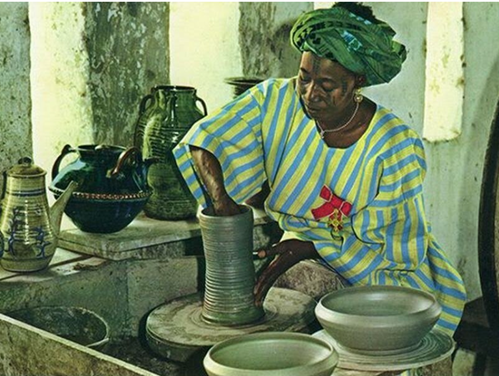
Source: Athena Art Foundation
Born in the Kwali village, Gwari region of Nigeria in 1925, Ladi Kwali’s earliest work followed the Gbagyi ethnic pottery styles. The skill was accessible as her ethnic group followed the tradition of women learning and practising pottery. This was true for many other groups, pottery beyond its artistic purposes had the very practical role of water storage and other everyday uses. The clay used was mined and made wet for pliability. Grit or ‘grog’ constituting finely broken pebbles and sand was added to the wet clay for structure and workability (from, The Pottery Wheel). Kwali trained under the guidance of her aunt, learning the indigenous practices of clay modelling that involved coiling, pinching, and beating clay. Unlike several western forms of pottery, the coiling technique did not use a wheel. Ladi Kwali would place soft clay on a plinth and walk around the piece, working to assemble coils around soft clay that were then joined together by the pressure applied by the artists’ fingers. The artist would, when making taller or larger structures, scrape the upper rim of the pot so that new clay would adhere to the surface. Clay was moulded into flat bowls or pulled upwards when requiring height, finally being smoothed, and shaped using various wooden tools. The product was then fired in open bonfires to harden into their final forms. The evidence for the existence of the above technique dates to around 700 B.C.
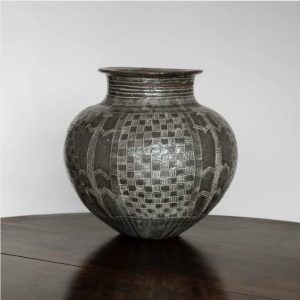
Source: The Oxford Ceramics Gallery
Ladi Kwali’s skill at pottery was recognised at a young age, being well known as a talented potter in the region. It was this renown that led even the Emir of Abuja (now Suleja), Alhaji Suleiman Barau, to collect and display a few of her pieces revealing her expertise to Michael Cardew. Cardew was a ceramist who conducted extensive research on pottery in the region and held the position of pottery officer in the colonial Nigerian government. He set up the Pottery Training Centre in Abuja where Ladi Kwali became the first female potter. It was here that she learned several new techniques and styles beyond traditionally practised pottery. Wheel throwing, glazing, kiln firing and the use of slip that is not common in traditional African pottery was introduced to her here. Completing her training in January 1959, Kwali was employed as an instructor at the institute, where she went on to develop her techniques for a long time.
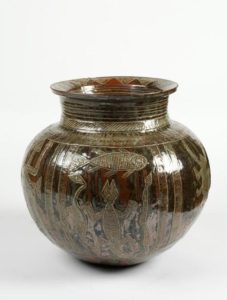
Source: Archives of Women Artists Research and Exhibition (AWARE)
Kwali developed a distinctly eclectic style that did not let go of the conventional pottery style she had learned, but simply adapted them together with western studio pottery. She incorporated stoneware clay from the centre in traditional hand-shaped pottery. Her work now involved sgraffito- an Italian technique that layered two surfaces of different colours so that scratching the upper layer would cause the colours of the lower layer to be displayed. Deep incisions that revealed coloured bases on white porcelain, layering using slips of white over red that were then revealed using porcupine quill were also practised by her. The usage of a closed furnace was another difference from the open kilns that were used widely. Glazing was an addition, typically Ladi Kwali would fire her pots with a celadon glaze. True to the roots of her culture, Ladi Kwali’s pieces continued to depict images of birds, lizards, fish and other nature related imagery. She used the conventional technique of carving on the clay’s surface using a roulette- a wooden tool shaped like a cylinder.
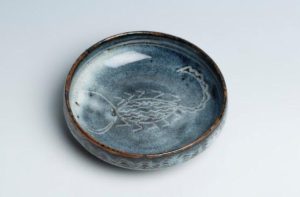
Source: Archives of Women Artists Research and Exhibition (AWARE)
Her creations caused a wider recognition for the traditional skill primarily practiced by women, with Ladi Kwali’s work being elevated to being art objects than the often dismissively used term “craft”. The technical perfection of her pieces was also taken note of as they now became impervious and heavier. The Oxford Ceramics Gallery referring to her collection says, “Kwali’s work was an effective bridge between African and European influences, her pots full of expressive spirit, with her jars in particular having a powerfully sculptural quality…Even her smallest pieces had the almost indescribable life and energy of the most natural of potters.” Her work continues to hold great cultural significance beginning with the exhibitions held by Cardew on Abuja pottery in 1958, 1959 and 1962. Her pieces are held in collections at the Smithsonian National Museum of African Art, Victoria and Albert Museum, and Aberystwyth University Ceramics Gallery.
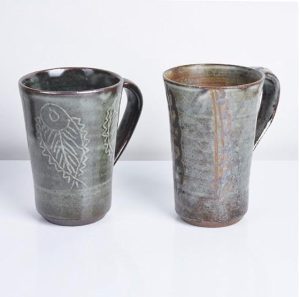
Source: Archives of Women Artists Research and Exhibition (AWARE)
The art she produced resulted in her being awarded an MBE in 1963. She received an honorary doctoral degree from Ahmadu Bello University, Zaria. In 1980, she was awarded the highest national honour for academic merit by the Nigerian government, the Nigerian National order of Merit Award (NNOM). Her relevance has not faded to this day, with the 2022 exhibition titled, Body Vessel Clay, Black Women, Ceramics & Contemporary Art held at Two Temple Place, England, marking her at the beginning of a journey across Black women ceramic artists covering a history of 70 years. Today the pottery centre in Abuja is known as the Dr Ladi Kwali Pottery Centre, renamed after her death in 1984. Ladi Kwali’s life and work remains an inspiration for many and is testament to the resilience of indigenous art forms as well as the artists who make them. The flourishing of these works and the memory of these names allows for the retention of histories that several forces once tried to erase or had not received due credit in time.
SOURCES:
https://www.britishmuseum.org/collection/term/BIOG125301
https://awarewomenartists.com/en/artiste/ladi-kwali/
https://www.oxfordceramics.com/artists/107-ladi-kwali/overview/
https://www.athenaartfoundation.org/new-ladykwali
https://thepotterywheel.com/historical-coil-pots/#africa





